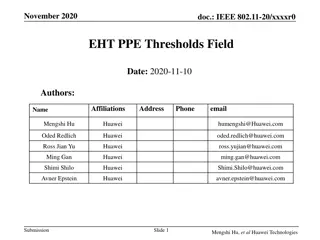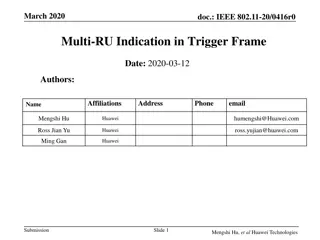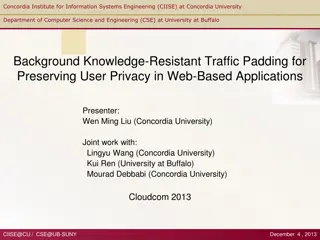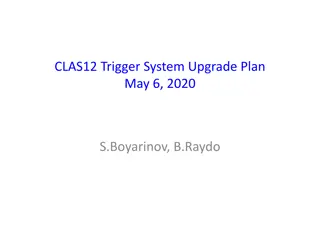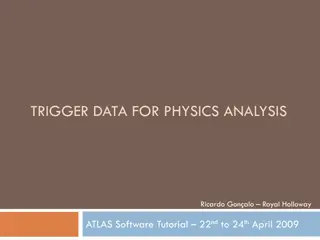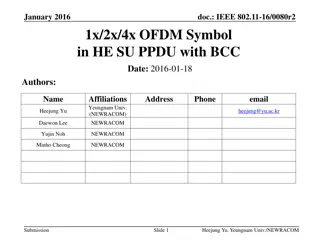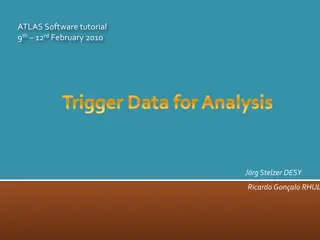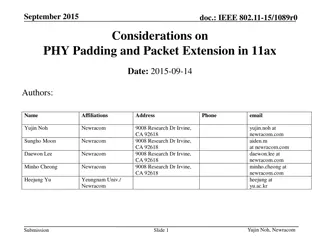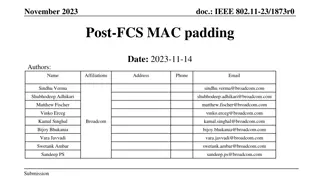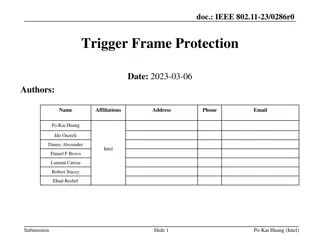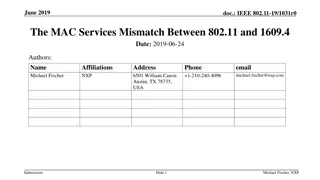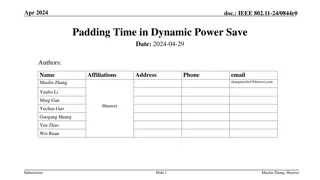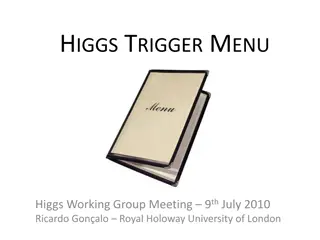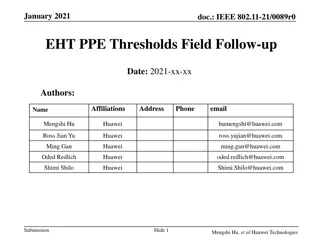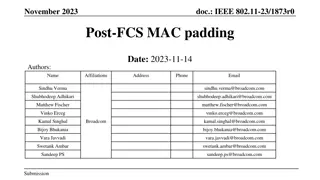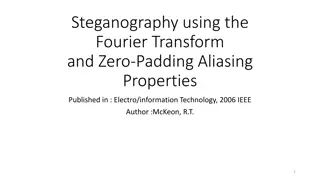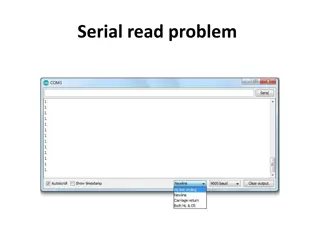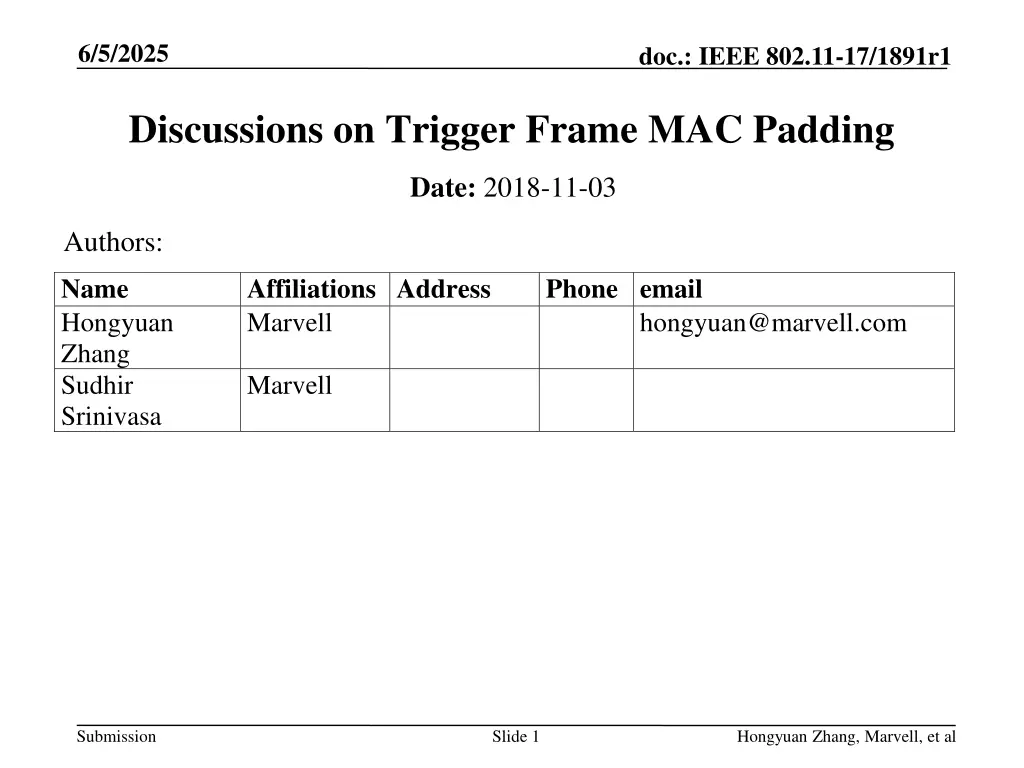
IEEE 802.11-17/1891r1 Discussions on Trigger Frame MAC Padding
Explore the discussions surrounding Trigger Frame MAC Padding in the IEEE 802.11-17/1891r1 document. Issues related to timing, equations, LDPC coding, and padding considerations are analyzed for accurate implementation.
Download Presentation

Please find below an Image/Link to download the presentation.
The content on the website is provided AS IS for your information and personal use only. It may not be sold, licensed, or shared on other websites without obtaining consent from the author. If you encounter any issues during the download, it is possible that the publisher has removed the file from their server.
You are allowed to download the files provided on this website for personal or commercial use, subject to the condition that they are used lawfully. All files are the property of their respective owners.
The content on the website is provided AS IS for your information and personal use only. It may not be sold, licensed, or shared on other websites without obtaining consent from the author.
E N D
Presentation Transcript
6/5/2025 doc.: IEEE 802.11-17/1891r1 Discussions on Trigger Frame MAC Padding Date: 2018-11-03 Authors: Name Hongyuan Zhang Sudhir Srinivasa Affiliations Address Marvell Phone email hongyuan@marvell.com Marvell Submission Slide 1 Hongyuan Zhang, Marvell, et al
6/5/2025 doc.: IEEE 802.11-17/1891r1 CIDs on TF MAC Padding (1) 15662Hongyuan Zhang 27.5.3.2.2 282.22 "An AP transmitting a PPDU that contains a Trigger frame or frame containing a TRS Control subfield shall ensure that the duration of the PPDU that follows BSYM is greater than or equal MinTrigProcTime indicated by the soliciting non-AP STA (see Table 9-262z (Subfields of the HE MAC Capabilities Information field)). BSYM is the OFDM symbol of the PPDU that contains either the last bit of SCH when BCC is used to encode the PSDU or the last coded bit of the LDPC codeword that encodes the last bit of SCH when LDPC is used to encode the PSDU," This sentence may have issues mathematically from PHY perspecitve. The description implies that the amount of MAC padding for trigger frame should be equivalent to the duration as defined in MinTRigProcTime AFTER the BSYM symbol boundary--meaning that MAC needs to find BSYM first. However this is contradictory to the math description of the number of octets in the MAC padding field as indicated by equations (9-0b) and (9-0c). We need to either (1) Adjust the text here to match the equations (9-0b) and (9-0c); or (2) Change the equations to reflect the text here. However, option(2) seems extremely difficult mathematically and too late for implementation, especially for the case of LDPC. This is because: First, it is awkward for MAC to compute the OFDM symbol boundary before even fully figuring out all the MAC fields; secondly and more importantly, the LDPC codeword length, extra symbol insertion, and other parameters are a function of the total number of data bits (see 19.3.11.7.5), while MAC padding field is part of the data bits to be encoded, so this ends up to a chicken and egg situation, and might be too late to address. Revise the text to reflect the equations in (9-0b) and (9-0c), i.e. Option(1) in the comment. Submission Slide 2 Hongyuan Zhang, Marvell, et al
6/5/2025 doc.: IEEE 802.11-17/1891r1 CIDs on TF MAC Padding (2) 104.15 eq 9-0b and eq 9-0c don't consider LDPC coding in which one CW could include both user info field and padding field. such that the padding bits cannot gain processing time to process the trigger frame. Since the number of padding bits depends on MCS, and it's case by case regarding if user info field and padding field belong to the same LDPC CW or not, it's better to remove the equations and leave the padding bits to implementation. 16983 Xiaogang Chen 9.3.1.23 282.25 Shall ensure that the duration of the PPDU that follows BSYM is greater than or equal MinTrigProcTime indicated by the soliciting non-AP STA. The decoding could end before the end of the BSYM because pre-FEC padding have 4 possible segments. The post-FEC padding with in the symbol can be used to parse trigger frame. so if inTrigProcTime is counted after BSYM, AP are adding more padding than the non-AP STA needed. replace "BSYM is the OFDM symbol of the PPDU that contains either" with "BSYM is the PPDU that contains either" 16984 Xiaogang Chen 27.5.3.2.2 Submission Slide 3 Hongyuan Zhang, Marvell, et al
6/5/2025 doc.: IEEE 802.11-17/1891r1 TF Padding Issues Text in 27.5.3.2.2 is ok with BCC, but it does not have the right assumption of LDPC encoding flow: BCC is convolutional code (no concept of code words), so this padding flow is OK: Add 2nd portion MAC Padding bits corresponding to additional number of OFDM symbols with duration equal to or larger than MinTrigProcTime Find BSYM OFDM symbol boundary containing the last bit before BCC encoding BCC coding, Modulation... Add 1st portion MAC Padding bits (pre-FEC) to fill in till BSYM -th OFDM Symbol Find Last bit of SCH LDPC s is block code, and its parameters {LLDPC, NCW, Nshrt, Npunc, Nrep, LDPC Extra Symbol} are all determined by the PSDU length and coded bit length (i.e. Npld Navbits ) refer to 19.3.11.7.5in Revmd D1.0. However, MAC padding bits is also part of PSDU See illustration in next page Submission Slide 4 Hongyuan Zhang, Marvell, et al
6/5/2025 doc.: IEEE 802.11-17/1891r1 Cont d Compute LDPC parameters, and find the LDPC CW containing the last bit, assuming no additional (pre- FEC) MAC padding bits Add 2nd portion MAC Padding bits corresponding to additional number of OFDM symbols with duration equal to or larger than MinTrigProcTime Add 1st portion MAC Padding bits (pre-FEC) to fill in till BSYM -th OFDM Symbol Find Last bit of SCH Find BSYM OFDM symbol boundary containing the last bit of the last CW Find Npld1 Compute 1st set of LDPC parameters {LLDPC1, NCW1, Nshrt1, Npunc1, Nrep1, LDPC Extra Symbol1} Find Npld2 Re-Compute LDPC parameters, with MAC padding bits as part of PSDU All the original LDPC CW boundary computation may be invalid! Because the LDPC parameter changes after MAC padding inserted Compute 2nd set of LDPC parameters {LLDPC2, NCW2, Nshrt2, Npunc2, Nrep2, LDPC Extra Symbol2} Submission Slide 5 Hongyuan Zhang, Marvell, et al
6/5/2025 doc.: IEEE 802.11-17/1891r1 Cont d Without knowing number of MAC padding bits, even the LDPC CW Length cannot be determined. The BSYM computation for each user info field is even more complex at the AP side. Submission Slide 6 Hongyuan Zhang, Marvell, et al
6/5/2025 doc.: IEEE 802.11-17/1891r1 LDPC Example Consider a trigger frame with payload size ~260 bytes An example is a 6-user MU-BAR trigger frame 8bytes CommonInfo + 41bytes UserInfo/user Let s assume the trigger frame payload is LDPC encoded and transmitted on a 20MHz VHT MCS0 PPDU We consider the case with MinTrigProcTime = 16us The procedure in Slide 5 results in an additional LDPC codeword to be added when recomputing the LDPC parameters In total, about 40 (!) additional OFDM symbols worth of padding bits are needed, if AP really wants to satisfy the BSYM requirement . Submission Slide 7 Hongyuan Zhang, Marvell, et al
6/5/2025 doc.: IEEE 802.11-17/1891r1 Possible Approaches Option-1: provide a closed form method for LDPC to satisfy the BSYM searching text One example in Appendix Extremely complex for both spec writing and AP implementation. Option-2: Limit the PPDU formats/coding when carrying TF: Example: Not allow 11n/11ac PPDU + LDPC. 11ax PPDU with LDPC may be ok, AP may chose to append PE duration long than STA s PPE threshold, to provide more time for TF processing. Option-3: remove the BSYM searching text from the spec and leave the padding method to AP implementation. For LDPC, the issue described above may still exist depending on implementation, STA may need to optimize its TF processing timing for LDPC. May still apply Option-2 (TBD). Submission Slide 8 Hongyuan Zhang, Marvell, et al
6/5/2025 doc.: IEEE 802.11-17/1891r1 Straw Poll Which direction in slide 9 do you prefer? Op-1 Op-2 Op-3 Submission Slide 9 Hongyuan Zhang, Marvell, et al
6/5/2025 doc.: IEEE 802.11-17/1891r1 Appendix: An example closed form LDPC Solution Assume the worst case of LDPC parameters before computing the MAC padding length, e.g. LCW=1944, so that sufficient extra Rx processing time is always guaranteed. Still requires compute LDPC parameter two times (before and after MAC padding), very complex if we want to cover all corner cases. In most cases, more than necessary MAC padding will be added, more overhead on the trigger frame. Example math process next page. Submission Slide 10 Hongyuan Zhang, Marvell, et al
6/5/2025 doc.: IEEE 802.11-17/1891r1 Maths ??????? ?? ????? ???? ???????? ???????? X+16 ????? ? ????? ? ?_????? = ???? ? + ?? ??????? ?? ????? ???? ???? ?????? ???????? ?_????? ?_????2 = ???? ????? ??????+ ? ?_????? ????? ??????+? ??????? ?? ??????? ??? ??????????????? ????????? MinTrigProcTime (in us) ? ?????????? ??????? ?? ????? ?????? ??? ?? ?????????? +3 ????? ?_????3 = ????? ? ?_????? ?_????3 ?_????2 ? ? ??? ?_????4 = ??? ?,???? ????? (??????+ ?) ????? (??????+?) Submission Slide 11 Hongyuan Zhang, Marvell, et al


